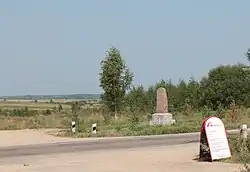Lyady, Vitebsk Region
Lyady (Belarusian: Ляды; Russian: Ляды) is an agrotown in Dubrowna District, Vitebsk Region, Belarus. It is adjacent to the Belarus–Russia border. Until 2008, it had the status of village.[1]
Lyady
Ляды | |
|---|---|
.jpg.webp) Lyady post office, 1930 | |
 Lyady | |
| Coordinates: 54°36′1″N 31°10′4″E | |
| Country | Belarus |
| Region | Vitebsk Region |
| District | Dubrowna District |
| Founded | 17th century |

History
Lyady was founded in the 17th century. It was located on the road connecting Moscow and Warsaw. It is located near the Mereya River, once the border between Russia and Poland and later between the Russian Soviet Federative Socialist Republic and the Byelorussian Soviet Socialist Republic.[2]
During the French invasion of Russia, on 14 August 1812, Ney and his troops crossed the former border into old Russia at Lyady, proceeding toward Smolensk. By 18 November, after the defeat, Napoleon spent a night in the village where they stumbled upon a barn with hens and ducks.[3]
Lyady used to have a predominantly Jewish population, located in the Pale of Settlement. It was a center of Chabad chasidism for over a decade. The first rebbe Shneur Zalman of Liadi settled there at the invitation of Prince Stanisław Lubomirski, voivode of the town, after his second imprisonment in 1800.
After the German occupation of Belarus in the Second World War, the town's Jews were gathered into a ghetto. On April 2, 1942, the Germans and collaborators killed more than 2,000 Jews in the ghetto.[2]
After a six-day battle from October 3–8, 1943, Lyady was cleared of German forces by the reinforced 30th Guards Rifle Division of 10th Guards Army.[4]
References
- "Национальный правовой Интернет-портал Республики Беларусь". pravo.by (in Russian).
- Вячеслав ТАМАРКИН. ГЛАС УБИЕННЫХ МОЛЧАТЬ НЕ ДАЕТ!. Международный еврейский журнал "МИШПОХА" (in Russian). Журнал "Мишпоха". Retrieved October 27, 2013.
- "1812 : eyewitness accounts of Napoleon's defeat in Russia". London : Readers Union : Macmillan. 7 August 1967 – via Internet Archive.
- David M. Glantz, Battle for Belorussia, University Press of Kansas, Lawrence, KS, 2016, p. 67